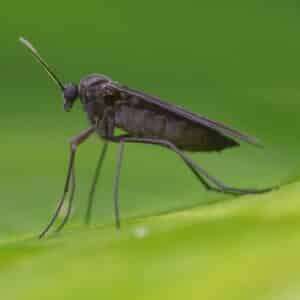

Dark Fungus Gnats: The Pest You’ll Never Forget
Dark Fungus Gnats are some of the most unforgettable pests you will ever see. Career pest control technicians in the Carolinas are seeing Dark Fungus Gnats for the first time in their decades long careers. And while they might be small in size, Dark Fungus Gnats make a big impression, especially during their bizarre and potentially disturbing larval stage. Read on to learn more about these unsettling pests that are catching the attention of many across the Carolinas.
What Are Dark Fungus Gnats?
Dark Fungus Gnats (also known as dark winged fungus gnats) are tiny, dark-colored flies that thrive in damp, shaded environments. As adults, they’re often mistaken for harmless fruit flies. They range in size from just 1/32 to 1/4 of an inch long. Despite their small size, they have a distinct look. Their soft, black bodies are often marked with subtle orange bands near the middle, helping to distinguish them from other gnats.
While adult gnats can be irritating in their own right, the real spectacle begins when you see their larvae.
Gnat Trains: A Creepy-Crawly Sight
If you’ve never seen a fungus gnat larval train, consider yourself lucky—or unlucky, depending on your fascination with the unusual and slimy. The larvae are worm-like with dark heads and pale, slender bodies. When present in large numbers, they travel together in long, wriggling lines—hundreds of them moving together in what looks like a living slug. These formations are called larval trains, and while they might make your skin crawl, they’re a fascinating example of insect behavior.
You’re most likely to witness this eerie migration on sidewalks, driveways, or moist garden soil, especially after rain. It’s both an amazing and repulsive sight that has caught the attention of scientists and homeowners alike. The stout of heart can view this phenomenon here.
Where Do They Live?
When they are not crawling in masses on your sidewalk, Dark Winged Fungus Gnats thrive in moist, shaded environments—especially at the base of trees, in garden soil, or around potted plants. These areas provide the damp conditions their larvae need to survive and grow. If you’re noticing swarms of small flies or the appearance of tiny crawling larvae, you may have a fungus gnat infestation on your hands.
In North and South Carolina, the warm, humid climate creates ideal conditions for these gnats, especially in spring and fall. Indoor infestations can also occur in greenhouses, plant nurseries, and even kitchens with houseplants that are watered too frequently.
Should You Be Concerned?
While the sight of fungus gnat larvae can be disturbing, they typically don’t pose a serious health threat. They do not bite; however, they can damage plant roots and become a persistent nuisance if left untreated. You don’t want to see these pests in your garden because they pose a danger to vegetables.
How to Eliminate Dark Fungus Gnats
If you suspect a Dark Fungus Gnat infestation on your property, you don’t have to face it alone. DIY methods may not be enough. At Anticimex Carolinas, we specialize in eco-friendly, effective pest control solutions tailored to homes and gardens across North Carolina and South Carolina. Our experienced team knows how to eliminate fungus gnats. We can assess your situation, identify the source of the infestation, and implement targeted treatments to eliminate these pests at all stages of their life cycle.
Contact Anticimex Carolinas today for expert help to reclaim your space from the unsettling presence of Dark Fungus Gnats.
